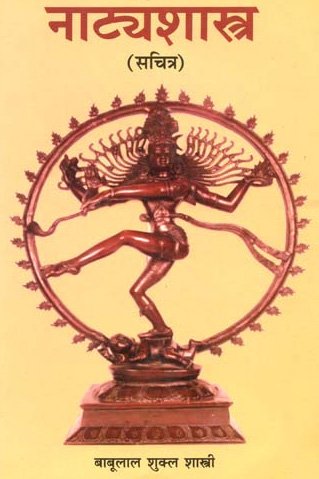Bhavini, Bhāvinī: 4 definitions
Introduction:
Bhavini means something in Hinduism, Sanskrit, the history of ancient India. If you want to know the exact meaning, history, etymology or English translation of this term then check out the descriptions on this page. Add your comment or reference to a book if you want to contribute to this summary article.
In Hinduism
Natyashastra (theatrics and dramaturgy)
Source: Wisdom Library: Nāṭya-śāstraBhāvinī (भाविनी) is the name of a meter belonging to the Khañjaka class described in the Nāṭyaśāstra chapter 32:—“the metre which has in its feet of nine syllables the first, the third, the fifth and the seventh and the last long, is bhāvinī”.

Natyashastra (नाट्यशास्त्र, nāṭyaśāstra) refers to both the ancient Indian tradition (shastra) of performing arts, (natya—theatrics, drama, dance, music), as well as the name of a Sanskrit work dealing with these subjects. It also teaches the rules for composing Dramatic plays (nataka), construction and performance of Theater, and Poetic works (kavya).
Purana and Itihasa (epic history)
Source: archive.org: Puranic EncyclopediaBhāvinī (भाविनी).—A female attendant of Subrahmaṇya. (Śalya Parva, Chapter 44, Verse 11).

The Purana (पुराण, purāṇas) refers to Sanskrit literature preserving ancient India’s vast cultural history, including historical legends, religious ceremonies, various arts and sciences. The eighteen mahapuranas total over 400,000 shlokas (metrical couplets) and date to at least several centuries BCE.
India history and geography
Source: Cologne Digital Sanskrit Dictionaries: Indian Epigraphical GlossaryBhāvinī.—(IA 10), same as Devadāsī; a dancing girl attached to a temple. Note: bhāvinī is defined in the “Indian epigraphical glossary” as it can be found on ancient inscriptions commonly written in Sanskrit, Prakrit or Dravidian languages.

The history of India traces the identification of countries, villages, towns and other regions of India, as well as mythology, zoology, royal dynasties, rulers, tribes, local festivities and traditions and regional languages. Ancient India enjoyed religious freedom and encourages the path of Dharma, a concept common to Buddhism, Hinduism, and Jainism.
Languages of India and abroad
Sanskrit dictionary
Source: Cologne Digital Sanskrit Dictionaries: Monier-Williams Sanskrit-English Dictionary1) Bhāvinī (भाविनी):—[from bhāvin > bhāva] f. a noble or beautiful woman, [Mahābhārata; Kāvya literature] etc.
2) [v.s. ...] a wanton woman, [Horace H. Wilson]
3) [v.s. ...] a [particular] musical composition, [Saṃgīta-sārasaṃgraha]
4) [v.s. ...] Name of one of the Mātṛs attending on Skanda, [Mahābhārata]
5) [v.s. ...] of the daughter of a Gandharva, [Mārkaṇḍeya-purāṇa]
Sanskrit, also spelled संस्कृतम् (saṃskṛtam), is an ancient language of India commonly seen as the grandmother of the Indo-European language family (even English!). Closely allied with Prakrit and Pali, Sanskrit is more exhaustive in both grammar and terms and has the most extensive collection of literature in the world, greatly surpassing its sister-languages Greek and Latin.
See also (Relevant definitions)
Starts with: Bhavinin.
Ends with: Aniruddhabhavini, Bhavavibhavini, Haribhavini, Tailabhavini, Tilabhavini.
Full-text: Aniruddhabhavini, Tilabhavini, Tailabhavini, Bhavin, Haribhavini, Sutrashatakanyaya, Likhitapathita, Vyushta, Bhamin.
Relevant text
Search found 14 books and stories containing Bhavini, Bhāvinī; (plurals include: Bhavinis, Bhāvinīs). You can also click to the full overview containing English textual excerpts. Below are direct links for the most relevant articles:
The Markandeya Purana (by Frederick Eden Pargiter)
Canto CXXVII - Avīkṣita’s exploits (continued)
Canto CXXXI - Marutta’s exploits (concluded)
The Tattvasangraha [with commentary] (by Ganganatha Jha)
Verse 1846 < [Chapter 21 - Examination of the doctrine of ‘Traikālya’]
Verse 1853-1856 < [Chapter 21 - Examination of the doctrine of ‘Traikālya’]
Sahitya-kaumudi by Baladeva Vidyabhushana (by Gaurapada Dāsa)
Text 4.39 < [Chapter 4 - First-rate Poetry]
The Buddhist Path to Enlightenment (study) (by Dr Kala Acharya)
The three Guptis (processes of controlling the inner nature of a Jīva) < [Chapter 4 - Comparative Study of Liberation in Jainism and Buddhism]
Harshacharita (socio-cultural Study) (by Mrs. Nandita Sarmah)
17. Music, Dance and Musical Instruments < [Chapter 6 - Other Socio-Cultural Aspects]
Dasarupaka (critical study) (by Anuru Ranjan Mishra)
Part 9 - Sentiments (rasa) used in a Samavakāra < [Chapter 6 - Samavakāra (critical study)]
Part 10 - Characters in the Samudramanthana < [Chapter 6 - Samavakāra (critical study)]